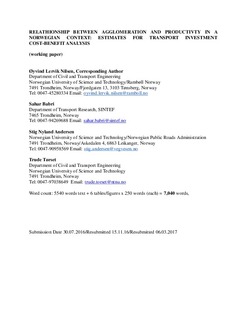Relationship between agglomeration and productivity in a Norwegian context: Estimates for cost benefit analysis
Journal article, Peer reviewed
Submitted version
Permanent lenke
http://hdl.handle.net/11250/2588003Utgivelsesdato
2017Metadata
Vis full innførselSamlinger
Originalversjon
Transportation Research Record, 2017, 2606 (8), 63-70 https://doi.org/10.3141/2606-08Sammendrag
Cost–benefit analysis (CBA) is an important tool in many countries in the evaluation of transport investments. The main objective of CBA is to allocate society’s shared resources by considering all costs and benefits to society as a whole. While direct costs and benefits are often straightforward to calculate, indirect costs and benefits are more challenging to include in a CBA. In relation to indirect benefits, increased attention has been paid to potential productivity benefits for firms that result from reductions in distance to other firms, workers, or customers. The literature on wider economic impacts and agglomeration economies suggests that such benefits usually exist but vary between sectors and nations. However, little consensus seems to exist on the size of the benefits. This paper analyzes the relationship between agglomeration, productivity, and transport investment in a Norwegian context. A total factor productivity approach was used to calculate productivity for 17,000 firms along the western coast of Norway in eight sectors from 2009 to 2013. For each firm, an agglomeration index was calculated, and a regression model was used to find the relationship between productivity and agglomeration. The results show that productivity varied between sectors and that no clear trend occurred across all sectors to show that increased agglomeration leads to increased productivity. The implications of these results in a CBA perspective is that care should be taken in seeing agglomeration as solely beneficial for all sectors and be more specific in relation to which sectors are affected in each transport investment project.
